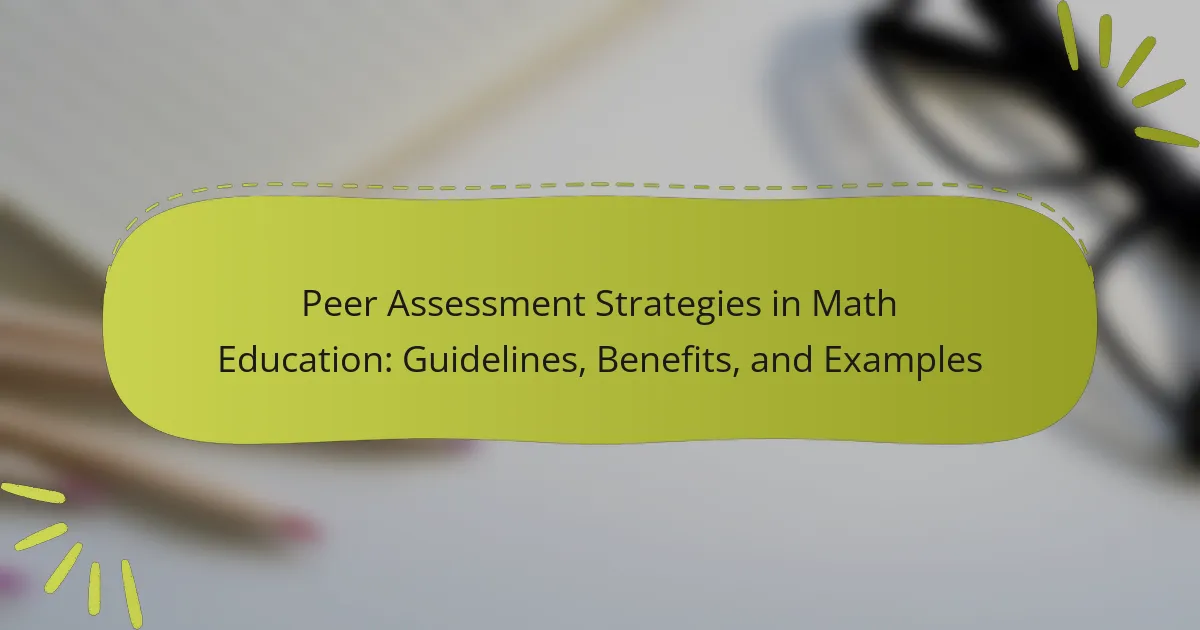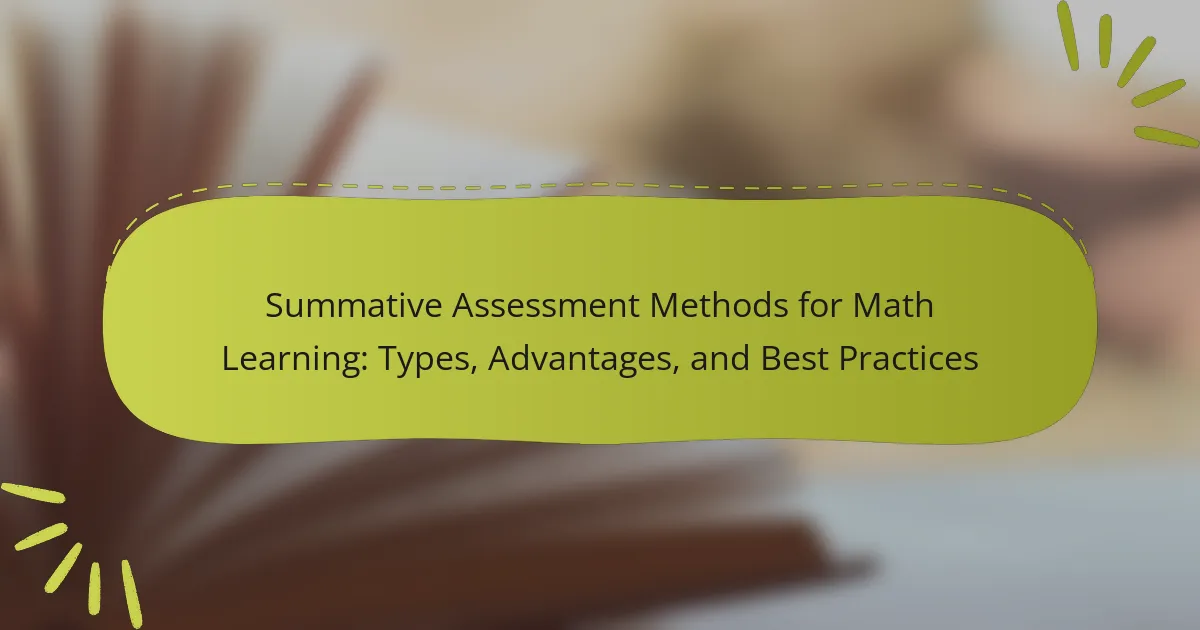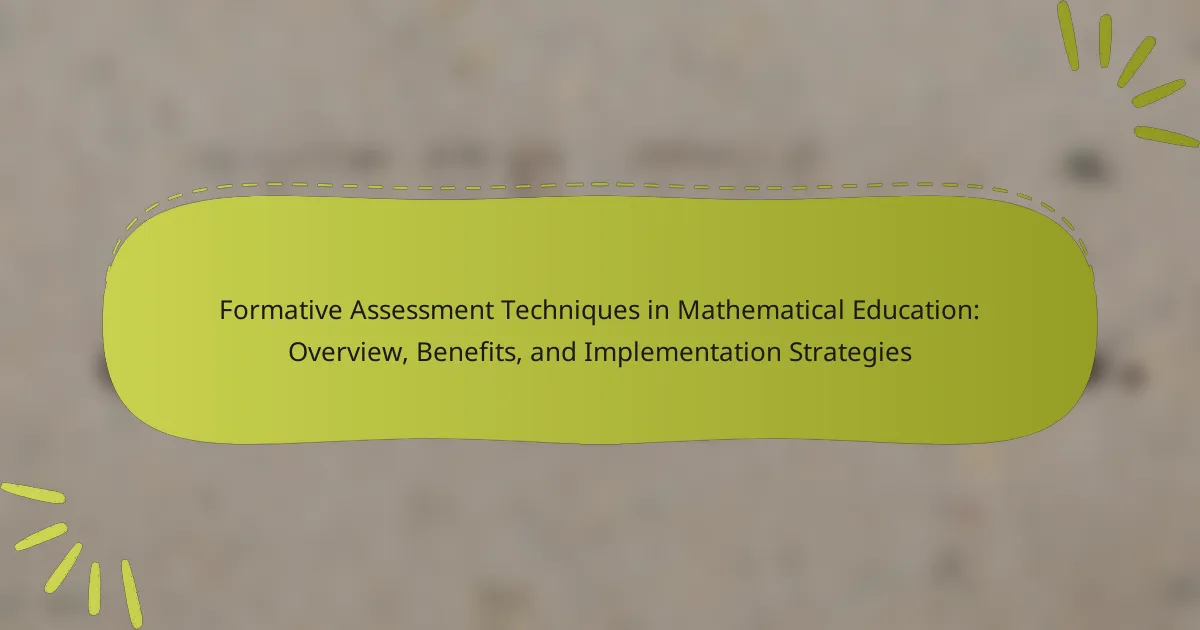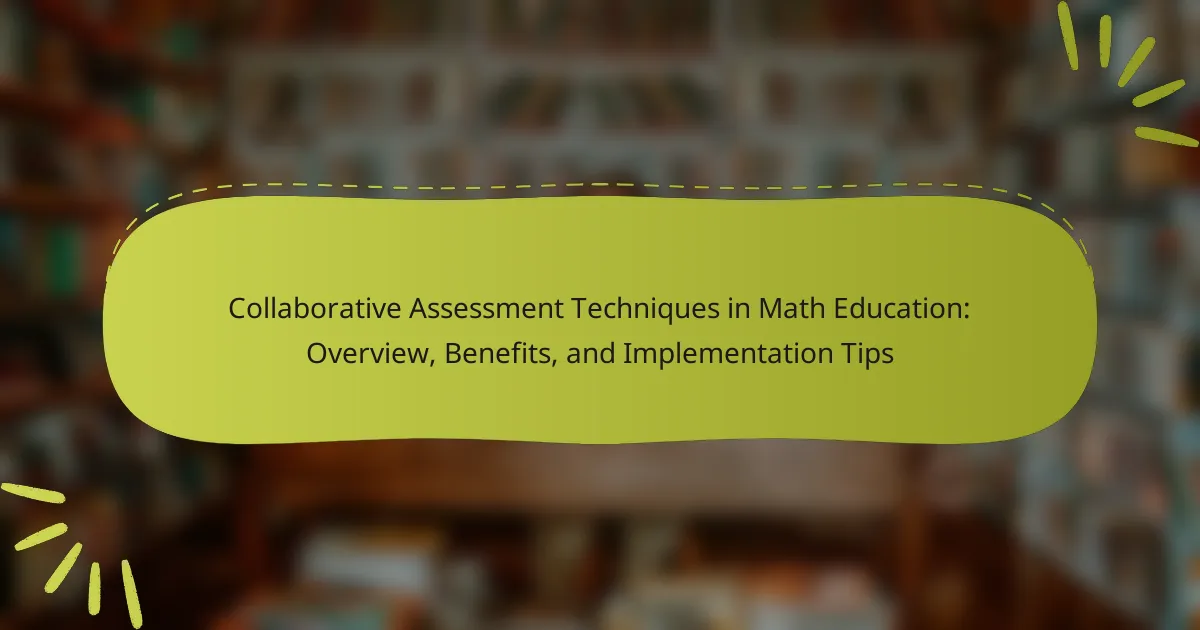Diagnostic assessment tools for mathematics are essential instruments used to evaluate students’ understanding and skills in math. These tools, which include quizzes, tests, and formative assessments, identify specific areas where students may struggle or excel, providing insights into their knowledge prior to instruction. Aligned with curriculum standards, these assessments enable educators to tailor instruction to meet individual student needs. Research indicates that effective diagnostic assessments enhance learning outcomes and support informed decision-making regarding teaching strategies. This article will explore the features, usage, and effectiveness of these diagnostic assessment tools in mathematics education.
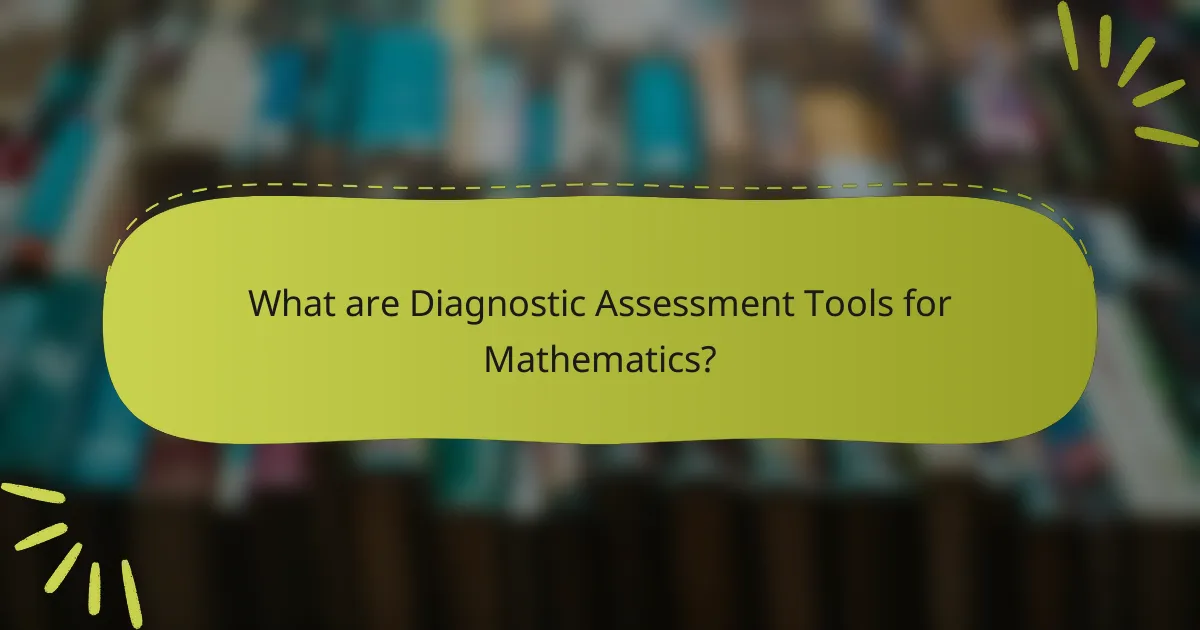
What are Diagnostic Assessment Tools for Mathematics?
Diagnostic assessment tools for mathematics are instruments designed to evaluate students’ understanding and skills in math. These tools identify specific areas where students may struggle or excel. They provide insights into students’ knowledge before instruction begins. Examples include quizzes, tests, and formative assessments. These assessments are typically aligned with curriculum standards. They can be used to tailor instruction to meet individual student needs. Research shows that effective diagnostic assessments improve learning outcomes. They help educators make informed decisions about teaching strategies.
How do Diagnostic Assessment Tools function in mathematics education?
Diagnostic assessment tools function by evaluating students’ understanding of mathematical concepts. They identify strengths and weaknesses in students’ knowledge. These tools provide immediate feedback to educators. This feedback helps tailor instruction to meet individual student needs. Common forms include quizzes, tests, and interactive assessments. They often focus on specific skills or topics. Research shows that timely interventions based on diagnostic assessments improve student outcomes. For instance, a study by Fuchs et al. (2006) demonstrated that targeted instruction based on diagnostic data significantly enhances learning in mathematics.
What are the key components of Diagnostic Assessment Tools?
Key components of Diagnostic Assessment Tools include validity, reliability, and specificity. Validity ensures that the tool measures what it is intended to measure. Reliability refers to the consistency of the assessment results over time. Specificity indicates the tool’s ability to accurately identify the presence or absence of specific skills or knowledge. Additionally, diagnostic tools often incorporate formative assessments, which provide ongoing feedback. They may also include detailed reporting features that highlight areas of strength and weakness. These components collectively enhance the effectiveness of diagnostic assessments in educational settings.
How do these components interact to assess mathematical understanding?
Components such as diagnostic assessments, instructional strategies, and feedback interact to assess mathematical understanding. Diagnostic assessments identify students’ current knowledge and misconceptions. Instructional strategies are then tailored based on these assessments to address specific learning needs. Feedback provides students with insights into their performance and areas for improvement. This cyclical interaction ensures that instruction is responsive and targeted. Research indicates that effective use of these components can lead to improved student outcomes in mathematics. For example, a study by Black and Wiliam (1998) highlights how formative assessments enhance learning by informing teaching practices.
What types of Diagnostic Assessment Tools are available for mathematics?
There are several types of diagnostic assessment tools available for mathematics. These tools include formative assessments, summative assessments, and standardized tests. Formative assessments are ongoing evaluations that inform instruction. They can include quizzes, observations, and student reflections. Summative assessments evaluate student learning at the end of an instructional unit. They often take the form of final exams or projects. Standardized tests are designed to measure student performance against a uniform standard. They provide data for comparing student achievement across different populations. Each type of tool serves a specific purpose in identifying student needs and guiding instructional strategies.
What are the differences between formative and summative assessment tools?
Formative assessment tools are used to monitor student learning during the instructional process. They provide ongoing feedback that can be used to improve teaching and learning. Examples include quizzes, discussions, and observations. These tools help identify areas where students are struggling. Summative assessment tools evaluate student learning at the end of an instructional unit. They measure the extent of learning and are typically used for grading purposes. Examples include final exams and standardized tests. The key difference lies in their timing and purpose. Formative assessments are diagnostic and iterative, while summative assessments are conclusive and evaluative.
How do technology-based assessments differ from traditional methods?
Technology-based assessments utilize digital platforms for evaluation, while traditional methods rely on paper-based formats. Digital assessments enable immediate feedback, enhancing learning opportunities. In contrast, traditional assessments often involve delayed grading and feedback. Technology-based assessments can incorporate multimedia elements, such as videos and interactive questions, to engage learners. Traditional methods typically consist of static questions without interactive components. Data analytics in technology-based assessments allows for personalized learning experiences based on individual performance. Traditional assessments lack this level of data-driven customization. Studies show that technology-based assessments can improve student engagement and retention rates compared to traditional methods.
What are the primary features of effective Diagnostic Assessment Tools?
Effective Diagnostic Assessment Tools have several primary features. They provide clear and measurable outcomes for student performance. These tools are aligned with curriculum standards to ensure relevance. They include a variety of question types to assess different skills. Effective tools offer immediate feedback to guide instruction. They are user-friendly for both educators and students. Additionally, they allow for tracking progress over time. Research shows that tools with these features lead to improved student learning outcomes.
How do these features contribute to accurate assessment?
The features of diagnostic assessment tools for mathematics enhance accurate assessment by providing targeted insights into student understanding. These tools often include formative assessments, which allow for real-time feedback on student performance. This immediate feedback helps identify specific areas of difficulty. Additionally, adaptive testing features adjust the difficulty level based on student responses. This ensures that assessments are appropriately challenging and relevant to each learner’s needs. Furthermore, detailed reporting features summarize student performance data effectively. This data can reveal trends and patterns in learning, facilitating informed instructional decisions. Research indicates that tools incorporating these features lead to improved student outcomes, as they enable educators to tailor their teaching strategies.
What role does feedback play in the effectiveness of these tools?
Feedback is crucial for the effectiveness of diagnostic assessment tools in mathematics. It provides learners with specific information about their performance. This information helps identify strengths and weaknesses in understanding mathematical concepts. Feedback also guides students on how to improve their skills. Research indicates that timely and constructive feedback can enhance student engagement and motivation. For example, a study by Hattie and Timperley (2007) found that feedback significantly influences learning outcomes. Effective feedback leads to better retention of knowledge and improved problem-solving abilities. Therefore, feedback is a fundamental component that drives the success of these assessment tools.
How can educators effectively use Diagnostic Assessment Tools?
Educators can effectively use Diagnostic Assessment Tools by integrating them into the teaching process. These tools help identify students’ strengths and weaknesses in mathematics. By analyzing the results, educators can tailor instruction to meet individual needs. This personalized approach enhances student engagement and learning outcomes. Research shows that targeted interventions based on diagnostic assessments improve student performance. For instance, a study by Black and Wiliam (1998) highlighted that formative assessments significantly boost academic achievement. Regular use of these tools fosters a growth mindset among students, encouraging them to embrace challenges. Overall, effective implementation of diagnostic assessments leads to more informed teaching strategies and improved student success.
What strategies can be employed to integrate these tools into the curriculum?
Integrating diagnostic assessment tools into the curriculum can be achieved through several strategies. First, educators should align the tools with learning objectives. This ensures that assessments measure relevant skills and knowledge. Second, professional development for teachers is essential. Training helps educators understand how to effectively use these tools. Third, incorporating technology into the classroom enhances engagement. Digital tools can provide immediate feedback, which supports learning. Fourth, regular data analysis is crucial. Teachers should review assessment results to inform instruction and identify student needs. Lastly, fostering a culture of continuous improvement encourages adaptation of strategies based on assessment outcomes. These strategies lead to more effective integration of diagnostic assessment tools in mathematics education.
How can teachers interpret the results from these assessments?
Teachers can interpret the results from these assessments by analyzing student performance data. They should identify patterns in strengths and weaknesses across different mathematical concepts. Comparing individual scores to class averages provides insight into overall understanding. Teachers can also use item analysis to determine which questions were most frequently missed. This helps identify specific areas where students struggle. Additionally, teachers can track progress over time to assess improvement. Utilizing rubrics can clarify expectations for student performance. Engaging in collaborative discussions with colleagues can enhance interpretation of results. These methods ensure that teachers can make informed decisions about instructional strategies.
What is the effectiveness of Diagnostic Assessment Tools in improving student outcomes?
Diagnostic Assessment Tools are effective in improving student outcomes. They provide targeted feedback that identifies specific learning gaps. This allows educators to tailor instruction to meet individual student needs. Research shows that students using these tools demonstrate higher engagement and achievement. For instance, a study by Black and Wiliam (1998) found that formative assessment practices, including diagnostic tools, can raise student performance by an average of 20 percentile points. Additionally, diagnostic assessments help in setting clear learning objectives. They enable progress tracking over time, fostering a growth mindset in students. Overall, these tools play a crucial role in enhancing educational effectiveness.
What evidence supports the use of these tools in mathematics education?
Diagnostic assessment tools enhance mathematics education by providing targeted feedback and personalized learning paths. Research indicates that these tools improve student understanding and retention of mathematical concepts. A study by Black and Wiliam (1998) found that formative assessment significantly boosts student achievement. Another research conducted by Hattie (2009) highlighted that feedback from diagnostic tools leads to higher student performance. Furthermore, a meta-analysis by Scriven (2016) demonstrated that effective use of these tools correlates with increased engagement in mathematics. These findings collectively support the integration of diagnostic assessment tools in mathematics education.
How do these tools impact student engagement and motivation?
Diagnostic assessment tools for mathematics significantly enhance student engagement and motivation. These tools provide immediate feedback, allowing students to understand their strengths and weaknesses. This instant feedback fosters a growth mindset, encouraging students to take ownership of their learning. Engaging formats, such as interactive quizzes and games, make learning more enjoyable. Research shows that students using these tools demonstrate increased participation in class activities. A study by Black and Wiliam (1998) found that formative assessments can lead to higher academic achievement. Furthermore, tailored assessments can meet individual learning needs, increasing student confidence. Overall, these tools create a more dynamic and responsive learning environment.
What challenges do educators face when implementing Diagnostic Assessment Tools?
Educators face several challenges when implementing Diagnostic Assessment Tools. One significant challenge is the lack of training in effectively using these tools. Many educators are not familiar with how to interpret the data generated by these assessments. This can lead to misinformed instructional decisions. Additionally, time constraints hinder the thorough implementation of these tools. Educators often struggle to find time in their schedules to administer assessments and analyze results.
Another challenge is the resistance to change from traditional assessment methods. Some educators may prefer conventional testing approaches and be hesitant to adopt new tools. Furthermore, the technology required for these assessments can be a barrier. Schools may lack the necessary resources or infrastructure to support digital diagnostic tools.
Finally, there can be inconsistencies in the reliability and validity of different assessment tools. Educators must ensure that the tools they choose are effective in measuring student understanding. These challenges collectively impact the successful implementation of Diagnostic Assessment Tools in educational settings.
What are common misconceptions about the use of these tools?
Common misconceptions about diagnostic assessment tools for mathematics include the belief that they only measure student performance. In reality, these tools also identify learning gaps and inform instruction. Another misconception is that they are only useful for standardized testing. Many tools provide ongoing feedback that enhances classroom learning. Some educators think that these assessments are time-consuming. However, many tools are designed for quick implementation and analysis. It is also a common myth that they are only for struggling students. In fact, they can benefit all students by tailoring instruction to individual needs. Lastly, some believe that results are always definitive. Diagnostic assessments should be viewed as part of a broader educational strategy that includes various data sources.
How can educators overcome barriers to effective implementation?
Educators can overcome barriers to effective implementation by adopting targeted strategies. First, they should provide professional development to enhance understanding of diagnostic assessment tools. Research shows that ongoing training increases teacher confidence and competence in using these tools. Second, educators must foster collaboration among staff to share best practices and resources. Studies indicate that collaborative environments lead to improved implementation outcomes. Third, they should involve stakeholders, including parents and administrators, to build a supportive community around the tools. Engaging stakeholders can lead to increased buy-in and resource allocation. Finally, educators need to continually assess and adjust their implementation strategies based on feedback and data. This adaptive approach ensures that the tools meet the specific needs of students.
What best practices should educators follow when using Diagnostic Assessment Tools for Mathematics?
Educators should follow structured guidelines when using Diagnostic Assessment Tools for Mathematics. First, they should clearly define learning objectives before administering assessments. This ensures that the tools align with educational goals. Next, educators must select appropriate diagnostic tools based on students’ grade levels and mathematical competencies. Using tools that match students’ needs improves the assessment’s effectiveness.
Additionally, educators should analyze the results thoroughly. This analysis helps identify students’ strengths and weaknesses in specific mathematical areas. Afterward, they should provide timely feedback to students. Immediate feedback enhances learning and allows for targeted interventions.
Moreover, educators are encouraged to involve students in the assessment process. Engaging students fosters a sense of ownership over their learning. Lastly, continuous monitoring and adjustment of instructional strategies based on assessment results are essential. This practice ensures that teaching methods remain effective and responsive to students’ evolving needs.
Diagnostic assessment tools for mathematics are designed to evaluate students’ understanding and skills in the subject, identifying areas of strength and weakness. The article outlines the functionality, key components, and various types of these tools, emphasizing their role in tailoring instruction to meet individual student needs. It discusses the importance of feedback, the differences between formative and summative assessments, and the impact of technology-based assessments. Furthermore, it highlights best practices for educators in implementing these tools effectively to enhance student engagement and improve learning outcomes. The article also addresses challenges and misconceptions associated with diagnostic assessments in mathematics education.
